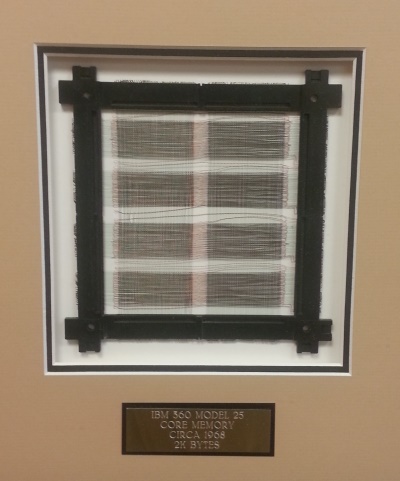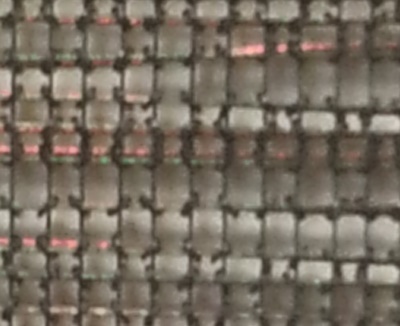Here’s something I saw framed on a client’s wall today. The plaque reads
IBM 360 MODEL 25
CORE MEMORY
CIRCA 1968
2K BYTES

Here’s a close-up that shows the cores, little ring magnets at the intersection of wires.

Related post: The weight of code
Here’s something I saw framed on a client’s wall today. The plaque reads
IBM 360 MODEL 25
CORE MEMORY
CIRCA 1968
2K BYTES

Here’s a close-up that shows the cores, little ring magnets at the intersection of wires.

Related post: The weight of code
Comments are closed.
That’s fun.
I saw some models of core memory at the Computer History museum in Mountain View a few weeks ago.
As a simulation designer, I’ll note that core memory was invented by computer pioneer Jay W. Forrester of MIT. Forrester later moved to MIT’s Sloan business school and invented the business simulation discipline of System Dynamics!
My friend Mike has a lovely macro photo of core memory on his flickr site:
http://www.flickr.com/photos/parquin/6659658685/in/set-72157594504211237
In college one of my professors claimed this type of memory was being pursued during the height of the Cold War because it would be more resilient to a nuclear blast.
My father-in-law was a technical manager at IBM Watson (and later president of IEEE). He worked on memory. He has a trade-show-style exhibit in his home that shows the evolution of memory density from pre-System-360 to the first integrated circuits.
…and he still cannot really believe that it is possible to put 64 gigabytes on a thumb drive. He knows all the reasons that’s impossible.
I happened to work on a PDP-8 system in the mid 80’s that still used core memory. One feature of core that’s not usually mentioned is that it’s persistent. If a system wouldn’t boot from tape we would load diagnostic code into the core on a working system and plug it into the non-working system then start it up from the front panel switches. Also restart on Monday morning was easy, just start right up, no reloading code.
The persistence of core memories was often important. In the late ’70s & early ’80s I used a mini (Interdata, later Perkin Elmer, 8/16) that kept the boot loader in core. So when the system went down, there was no need to re-enter the loader. If it got corrupted, then the loader had to be re-entered usinfg a hex keypad.
In the early-to-mid ’80s I was technical lead on a factory automation system that involved a central PDP-11 and several remote LSI-11 micros (think RS-232 star). We used core on the LSI-11s since they had no hard drives, so upon reboot each would calculate checksum on the stored code, and if okay, take off running. If not ok, then it would request a fresh copy of the code from the central machine.
My first job out of college was designing a temperature tracking power supply for core memory. It had to increase about 750 mV over a 175 degC swing. Later on I ended up testing and modifying the x-y drivers and the sense amps. Not rocket science, but interesting work for a first real world job. The raw core mat was 16K 32 bit words and was about the size of your fist, including packaging.
John, I have to comment here because I am the source of the core memory. We clearly share the same client in Southern California. I am a long time IBMer and actually worked on the machine that this came out of. The 360 Mod 25 was used as a front end to a check sorter. This one was at Security Pacific Bank on Brand Blvd in Glendale still in production in the late 70s. One of the things you’ll notice is the row of 18. That’s 2 bytes that are parity checked by one bit. This machine was odd parity, so any time an even number of bits were detected, it would hard stop with an error.